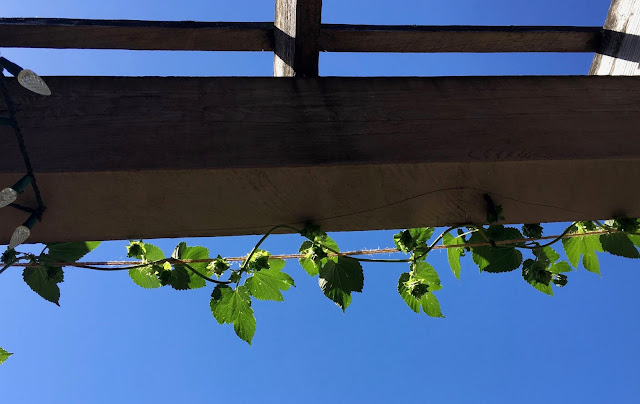Hops to it in the backyard
 |
| Look up: Hops overhead. (Photo: Kathy Morrison) |
Brewery’s project lets members of the community be micro hop farmers
By Kathy Morrison
I have a batch of beer growing in my backyard.
OK, it’s a part of a batch of beer, a very small part. But the hop cones on the bine (or vine) that twines its way up my pergola are tagged for a future fresh-hops beer at Sacramento’s New Helvetia Brewing Co.
There are several dozen of us micro hop farmers participating in the brewery’s Hops in My Back Yard (HIMBY) project. Dave Gull, founder and CFO of New Helvetia, says the project started in 2014 and has grown each year. In early spring, the brewery supplies (for a $10 fee) participants with a hop rhizome and basic instructions for planting. Make sure you have plenty of room for it to grow vertically, the brewery warns.
 |
| Hop cones in formation (Photo courtesy Dave Gull) |
The project started with four varieties of hops, Gull says: Willamette, Chinook, Centennial and Cascade. But the Cascade hops like our climate best, and produce the best yield, so that’s the only type used in HIMBY now, he notes.
Sacramento was a hops-producing region long before it became known for tomatoes. In the 19th century and up to Prohibition, hundreds of acres of hops grew in what is now Campus Commons (home of Sacramento State) and Sloughhouse. Gull says traditionally hops were planted in riverlands. The hardy perennials need a sunny climate and of course plenty of room to grow up.
The most obvious hop farm in the region now is the Ruhstaller plot along Interstate 80 in Dixon, but there also are hops growing near Hood Franklin Road west of Interstate 5, as well as near Woodland and Winters, Gull says. But none of those plots is on the scale of the early farms, he notes. You can see hops up close when the State Fair opens July 13: The fair’s Farm features a long archway completely shaded by hop bines.
My Cascade rhizome was the size of a pencil, about 8 inches long. I targeted a square of clay soil next to the sunny southwest corner of the 10-foot-tall pergola, loosening it down at least a foot and adding plenty of compost and earthworm castings. The rhizome was planted horizontally, just a few inches deep, on March 31. I tied three lengths of hemp twine to the top of the pergola and anchored the other ends with garden staples around the rhizome plot. Another length of twine was stretched across the upper edge of the pergola for horizontal growth.
I kept the soil moist but not too moist, which is a good thing, since Gull says a lot of HIMBY failures are due to overwatering and subsequent crown rot. Even though there was plenty of room for the bine to grow, I still was not prepared for how fast it sprouted. It was 9.5 inches tall by April 20, 13 inches on April 21 and 25.5 inches by April 24. Then it really took off: 6 feet tall on May 8.
The first bine seems to have stopped at its current 17 feet, and now is producing shoots all along its length. A second bine started stretching up early in June and is nearly 9 feet tall. I added two more hemp twine supports for the numerous shoots. The first cones appeared about 6 feet up when the plant reached 10 feet. The oldest cones now are about an inch long; Gull says they should double in length.
The cones contain what Gull calls the “magic yellow dust,” lupulin, which gives beer its distinctive hoppy smell and taste. Cascade hops have a mostly piney flavor profile, with citrus a subdued secondary characteristic.
 |
| Dave Gull's hop bines. (Photo courtesy Dave Gull) |
Gull is a HIMBY grower himself. He has 10 rhizomes planted in a 12-by-4-foot raised bed with about 8 inches of soil over a layer of weed block. (The roots can be invasive but are easier to dig out than, say, bamboo, he says.) Cables are strung between 16-foot posts anchored in concrete. He trims the early shoots back in spring so they won’t grow too fast too soon -- something I’ll have to remember next year.
At some point in August, the call will go out to the HIMBY growers: It’s time to harvest your hop cones. Gull recommends cutting the strings to bring down the bines, trimming the plant itself to about 2 feet above the soil level and then cutting the cones off the trimmed vines.
The fresh hops in the HIMBY batch will be augmented with pelletized hops. Some unexpected hops also might be in it, Gull says. In a previous year, a resident of Blue Canyon who was not a HIMBY grower brought in gallon plastic bags of hops he had harvested from a plant vining through a bunch of blackberry canes. It was probably a California heritage variety growing wild, Gull says. “It still went into the batch.”
Whatever winds up in the 2018 batch, it’ll be unique -- and a tiny bit mine.


Comments
Post a Comment